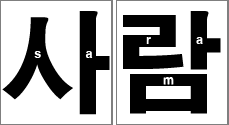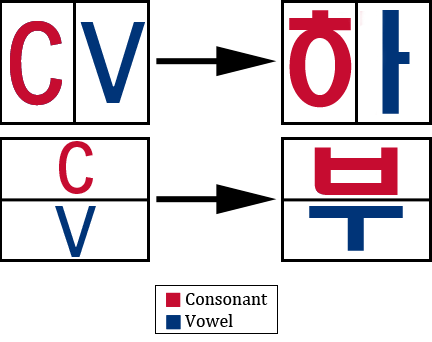Syllable Blocks
Korean words are written from left to right and words are formed by writing each syllable in a block-like shape. Each letter inside the block forms a sound. The word for 'person' is 사람, romanized as 'saram,' and consists of two syllables. The letters ㅅ + ㅏ make the syllable block of 사 ('sa'), while ㄹ + ㅏ + ㅁ make the next syllable 람 ('ram'). The picture below will show you a sound approximation of each of the Korean sounds contained in the word. Also note that written Korean doesn't actually draw boxes around the syllables, this is just for illustrative purposes.Korean syllables are organized into blocks of letters that have a beginning consonant, a middle vowel, and an optional final consonant. A syllable block is composed of a minimum of two letters, consisting of at least one consonant and one vowel. In our lesson plan, Steps 2, 3 and 4 will focus on just words with a consonant and one horizontal vowel, and words with a consonant and one vertical vowel (see below). Step 5 will introduce the final consonant concept and step 6 will show syllables that can consist of double vowels.
Also note if you want to write only a vowel, it must be written with the consonant ㅇ, which acts as a silent placeholder for the consonant position. Why? Think of the ying and the yang concept. If one wants to write the vowel ㅏ, they would have to write it as 아 with ㅇ being a silent placeholder for the consonant position. An easy way to remember this is to think of the ㅇ as a zero. More examples below:
| Original vowel | Written by itself |
|---|---|
| ㅏ | 아 |
| ㅐ | 애 |
| ㅓ | 어 |
| ㅔ | 에 |
| ㅗ | 오 |
| ㅜ | 우 |
| ㅡ | 으 |
| ㅣ | 이 |
Writing
As already mentioned, Korean words are written from left-to-right and top-to-bottom in block-like forms. In the next few sections you will learn how to write each letter and its appropriate stroke order. While stroke order may not seem important at first, it is important when writing Korean naturally and helps others to be able to read your handwriting. The shapes and size of the letters can be stretched or compressed to fill in the block space and to make it evenly sized with other all other syllables. In the example below, you can see how the size and shape of the letter ㄱ changes to fill in this imaginary block (highlighted in sky blue).Now we are going to start learning some letters, which are called jamo. Please note that, in order to view these lessons in their entirety, you must have Adobe Flash Player installed. This will allow you to play all included audio files on the following pages. Don't worry, you more than likely have it installed on your computer already.
source : http://learnkorean.128pro.net



댓글 없음:
댓글 쓰기